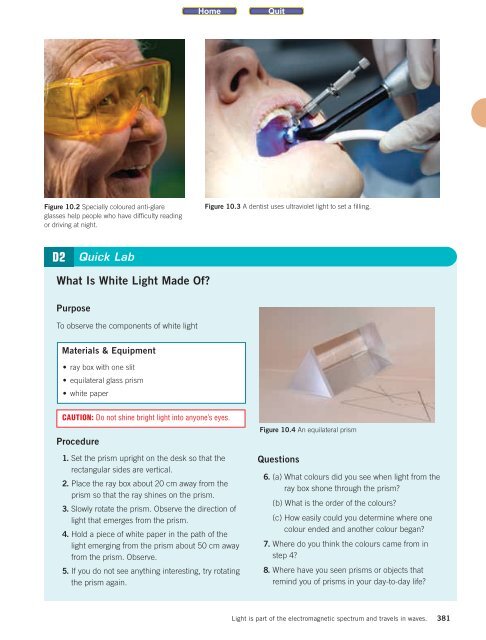is10_sb_unit_d
is10_sb_unit_d
is10_sb_unit_d
Create successful ePaper yourself
Turn your PDF publications into a flip-book with our unique Google optimized e-Paper software.
Figure 10.2 Specially coloured anti-glare<br />
glasses help people who have difficulty reading<br />
or driving at night.<br />
D2 Quick Lab<br />
What Is White Light Made Of?<br />
Purpose<br />
To observe the components of white light<br />
Materials & Equipment<br />
• ray box with one slit<br />
• equilateral glass prism<br />
• white paper<br />
CAUTION: Do not shine bright light into anyone’s eyes.<br />
Procedure<br />
1. Set the prism upright on the desk so that the<br />
rectangular sides are vertical.<br />
2. Place the ray box about 20 cm away from the<br />
prism so that the ray shines on the prism.<br />
3. Slowly rotate the prism. Observe the direction of<br />
light that emerges from the prism.<br />
4. Hold a piece of white paper in the path of the<br />
light emerging from the prism about 50 cm away<br />
from the prism. Observe.<br />
5. If you do not see anything interesting, try rotating<br />
the prism again.<br />
Figure 10.3 A dentist uses ultraviolet light to set a filling.<br />
Figure 10.4 An equilateral prism<br />
Questions<br />
6. (a) What colours did you see when light from the<br />
ray box shone through the prism?<br />
(b) What is the order of the colours?<br />
(c) How easily could you determine where one<br />
colour ended and another colour began?<br />
7. Where do you think the colours came from in<br />
step 4?<br />
8. Where have you seen prisms or objects that<br />
remind you of prisms in your day-to-day life?<br />
Light is part of the electromagnetic spectrum and travels in waves.<br />
381


